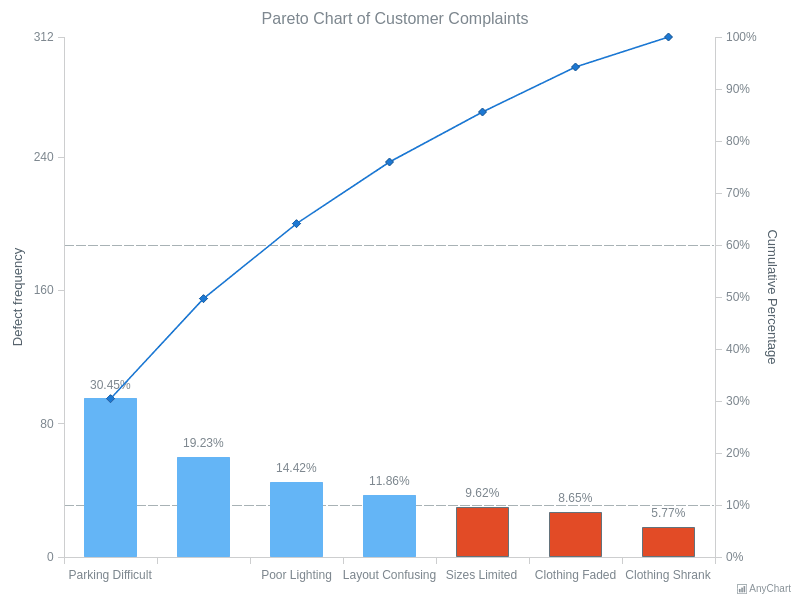Pareto analysis is a powerful technique that can be used to improve business efficiency. It can help you identify the most critical factors that are affecting your business and then prioritize them so that you can focus your efforts on the areas that will have the most significant impact. Keep reading to learn more about how you can use Pareto analysis to improve your business efficiency.
What are Pareto charts?

A Pareto chart is an efficient way to visualize how many different factors are contributing to a particular problem. The chart is named for Vilfredo Pareto, an Italian economist who observed that 80% of the land in Italy was owned by 20% of the population. The basic idea behind a Pareto chart is that you list all of the potential causes of a problem on the x-axis and then list how often each cause occurs on the y-axis. You can then use this information to identify which causes are having the most significant impact on your business.
A Pareto chart example includes if you’re trying to improve efficiency in your call center, you might find that 80% of customer complaints are caused by just 20% of your reps. This would allow you to focus your training efforts on those specific reps and hopefully see improvements in customer satisfaction.
What are the benefits of using Pareto charts?
When it comes to data analysis and visualization, there are several different tools and techniques that can be used in order to make the most of the information at hand. Among these is the Pareto chart, which is a graphical tool that is used to display the relative proportions of occurrence of different values. There are a number of benefits to using Pareto charts for data analysis. First, Pareto charts can help to identify the most important values within a data set. The critical values within a data set can include the mean, median, and mode, as well as the standard deviation and range.
The mean is the average of all the data points in a set, the median is the middle value when the data is sorted in ascending order, and the mode is the value that appears the most often in a set. The standard deviation measures how dispersed the data is around the mean, and the range is the difference between the smallest and largest values in a set. Another benefit of Pareto charts is that they can help identify trends in data. Trends in a dataset can include sudden changes in the data, long-term patterns, and correlations between different variables. For example, sudden changes can indicate either a natural event or an artificial event that has occurred in the data.
What type of data is best for Pareto charts?

There are many different types of analytical data that can be compared using Pareto charts. Some of the most common data types include percentages, number of items, and value of items. Percentages are a type of data often used to compare two or more items. For example, you may want to know what percentage of people in your city voted for a particular candidate. Percentages can also be used to compare data over time. The number of items is the number of individual pieces of data in a set.
The value of items is the amount of money that is associated with each piece of data in a set. For example, if you have a collection of data that includes the prices of different cars, the value of the items is the price of the vehicles.
How do you make a Pareto chart?
The best way to make a Pareto chart is by using Excel. To create a Pareto chart in Excel, you first need to create a data table with the desired data. Once the data table is created, you can then use Excel’s charting tools to make the chart. To start a data table, select the data you want to include in the chart. Then, in Excel, go to the “Data” tab and select “Table.” Excel will then create a table with the selected data.
Next, go to the “Charts” tab and select the “Pareto” chart type. You can customize the chart by formatting the bars, adding axes labels, and adjusting the chart’s layout. You can also add data labels to the chart to show the percentage values for each bar. Once the chart is customized to your liking, you can save it as a chart template to use again in the future.
What industries use Pareto charts?

Many industries use Pareto charts. Some of these industries include healthcare, business, manufacturing, and engineering. In the early days of the healthcare industry, Pareto charts were used to track the occurrence of certain medical problems. For example, a Pareto chart may be used to track the number of patients who are admitted to the hospital with a particular illness. Since then, the use of Pareto charts has evolved to include various applications. Today, Pareto charts are often used to track the performance of specific medical procedures. They can also be used to track the number of patients who are discharged from the hospital within a certain timeframe.
In the business world, Pareto charts are often used to track specific problems or issues. For example, a Pareto chart may be used to track the number of customer complaints that have been received in a given period of time. In the manufacturing industry, Pareto charts are often used to track the occurrence of defects. For example, a Pareto chart may be used to track the number of products that have been manufactured with a particular defect. In the engineering industry, Pareto charts are often used to track the occurrence of issues. For example, a Pareto chart may be used to track the number of products that have been designed with a particular flaw.
Conclusion
Pareto analysis can be used to improve business efficiency by helping to identify and focus on the most critical tasks. This can help to improve overall productivity and achieve better results.



